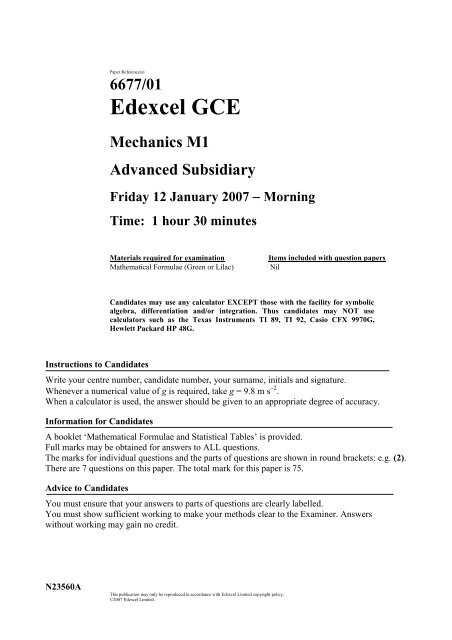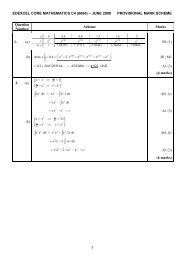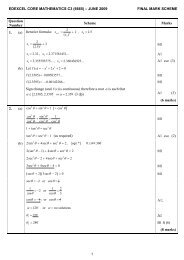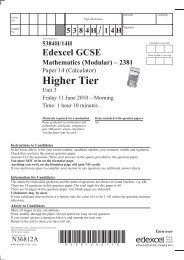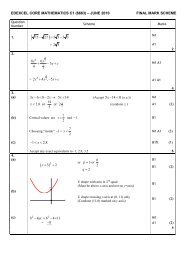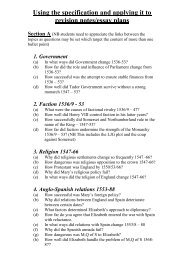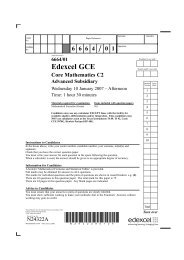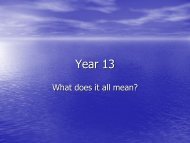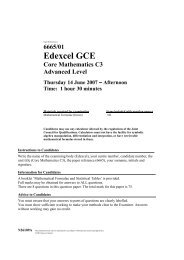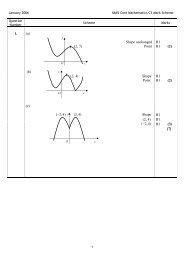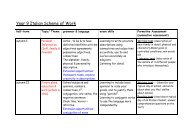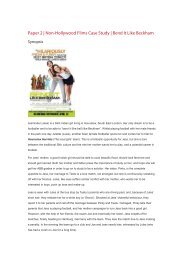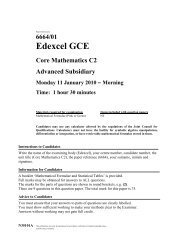January 2007 Question Paper
January 2007 Question Paper
January 2007 Question Paper
Create successful ePaper yourself
Turn your PDF publications into a flip-book with our unique Google optimized e-Paper software.
<strong>Paper</strong> Reference(s)<br />
6677/01<br />
Edexcel GCE<br />
Mechanics M1<br />
Advanced Subsidiary<br />
Friday 12 <strong>January</strong> <strong>2007</strong> Morning<br />
Time: 1 hour 30 minutes<br />
Materials required for examination<br />
Mathematical Formulae (Green or Lilac)<br />
Items included with question papers<br />
Nil<br />
Candidates may use any calculator EXCEPT those with the facility for symbolic<br />
algebra, differentiation and/or integration. Thus candidates may NOT use<br />
calculators such as the Texas Instruments TI 89, TI 92, Casio CFX 9970G,<br />
Hewlett Packard HP 48G.<br />
Instructions to Candidates<br />
Write your centre number, candidate number, your surname, initials and signature.<br />
Whenever a numerical value of g is required, take g = 9.8 m s 2 .<br />
When a calculator is used, the answer should be given to an appropriate degree of accuracy.<br />
Information for Candidates<br />
A booklet ‘Mathematical Formulae and Statistical Tables’ is provided.<br />
Full marks may be obtained for answers to ALL questions.<br />
The marks for individual questions and the parts of questions are shown in round brackets: e.g. (2).<br />
There are 7 questions on this paper. The total mark for this paper is 75.<br />
Advice to Candidates<br />
You must ensure that your answers to parts of questions are clearly labelled.<br />
You must show sufficient working to make your methods clear to the Examiner. Answers<br />
without working may gain no credit.<br />
N23560A<br />
This publication may only be reproduced in accordance with Edexcel Limited copyright policy.<br />
©<strong>2007</strong> Edexcel Limited.
1. Figure 1<br />
Q N<br />
30°<br />
P N<br />
A particle of weight 24 N is held in equilibrium by two light inextensible strings. One string is<br />
horizontal. The other string is inclined at an angle of 30° to the horizontal, as shown in<br />
Figure 1. The tension in the horizontal string is Q newtons and the tension in the other string<br />
is P newtons. Find<br />
(a) the value of P,<br />
(b) the value of Q,<br />
(3)<br />
(3)<br />
2. Figure 2<br />
A<br />
C<br />
D<br />
B<br />
1 m x m<br />
3 m<br />
A uniform plank AB has weight 120 N and length 3 m. The plank rests horizontally in<br />
equilibrium on two smooth supports C and D, where AC = 1 m and CD = x m, as shown in<br />
Figure 2. The reaction of the support on the plank at D has magnitude 80 N. Modelling the<br />
plank as a rod,<br />
(a) show that x = 0.75.<br />
(3)<br />
A rock is now placed at B and the plank is on the point of tilting about D. Modelling the rock<br />
as a particle, find<br />
(b) the weight of the rock,<br />
(c) the magnitude of the reaction of the support on the plank at D.<br />
(d) State how you have used the model of the rock as a particle.<br />
(4)<br />
(2)<br />
(1)<br />
N23560A 2
3. A particle P of mass 2 kg is moving under the action of a constant force F newtons. When<br />
t = 0, P has velocity (3i + 2j) m s –1 and at time t = 4 s, P has velocity (15i – 4j) m s –1 . Find<br />
(a) the acceleration of P in terms of i and j,<br />
(b) the magnitude of F,<br />
(c) the velocity of P at time t = 6 s.<br />
(2)<br />
(4)<br />
(3)<br />
4. A particle P of mass 0.3 kg is moving with speed u ms –1 in a straight line on a smooth<br />
horizontal table. The particle P collides directly with a particle Q of mass 0.6 kg, which is at<br />
rest on the table. Immediately after the particles collide, P has speed 2 m s –1 and Q has<br />
speed 5 m s –1 . The direction of motion of P is reversed by the collision. Find<br />
(a) the value of u.<br />
(b) the magnitude of the impulse exerted by P on Q.<br />
(4)<br />
(2)<br />
Immediately after the collision, a constant force of magnitude R newtons is applied to Q in the<br />
direction directly opposite to the direction of motion of Q. As a result Q is brought to rest<br />
in 1.5 s.<br />
(c) Find the value of R.<br />
(4)<br />
5. A ball is projected vertically upwards with speed 21 m s –1 from a point A, which is 1.5 m<br />
above the ground. After projection, the ball moves freely under gravity until it reaches the<br />
ground. Modelling the ball as a particle, find<br />
(a) the greatest height above A reached by the ball,<br />
(b) the speed of the ball as it reaches the ground,<br />
(c) the time between the instant when the ball is projected from A and the instant when the<br />
ball reaches the ground.<br />
(4)<br />
(3)<br />
(3)<br />
N23560A 3 Turn over
6. Figure 3<br />
20 °<br />
P N<br />
A box of mass 30 kg is being pulled along rough horizontal ground at a constant speed using a<br />
rope. The rope makes an angle of 20° with the ground, as shown in Figure 3. The coefficient<br />
of friction between the box and the ground is 0.4. The box is modelled as a particle and the<br />
rope as a light, inextensible string. The tension in the rope is P newtons.<br />
(a) Find the value of P.<br />
(8)<br />
The tension in the rope is now increased to 150 N.<br />
(b) Find the acceleration of the box.<br />
(6)<br />
N23560A 4
7. Figure 4<br />
A<br />
P (3 kg)<br />
30°<br />
Q (2 kg)<br />
0.8 m<br />
Figure 4 shows two particles P and Q, of mass 3 kg and 2 kg respectively, connected by a<br />
light inextensible string. Initially P is held at rest on a smooth fixed plane inclined at 30° to<br />
the horizontal. The string passes over a small smooth light pulley A fixed at the top of the<br />
plane. The part of the string from P to A is parallel to a line of greatest slope of the plane. The<br />
particle Q hangs freely below A. The system is released from rest with the string taut.<br />
(a) Write down an equation of motion for P and an equation of motion for Q.<br />
(b) Hence show that the acceleration of Q is 0.98 m s –2 .<br />
(c) Find the tension in the string.<br />
(4)<br />
(2)<br />
(2)<br />
(d) State where in your calculations you have used the information that the string is<br />
inextensible.<br />
(1)<br />
On release, Q is at a height of 0.8 m above the ground. When Q reaches the ground, it is<br />
brought to rest immediately by the impact with the ground and does not rebound. The initial<br />
distance of P from A is such that in the subsequent motion P does not reach A. Find<br />
(e) the speed of Q as it reaches the ground,<br />
(f) the time between the instant when Q reaches the ground and then instant when the string<br />
becomes taut again.<br />
(5)<br />
(2)<br />
END<br />
TOTAL FOR PAPER: 75 MARKS<br />
N23560A 5 Turn over


